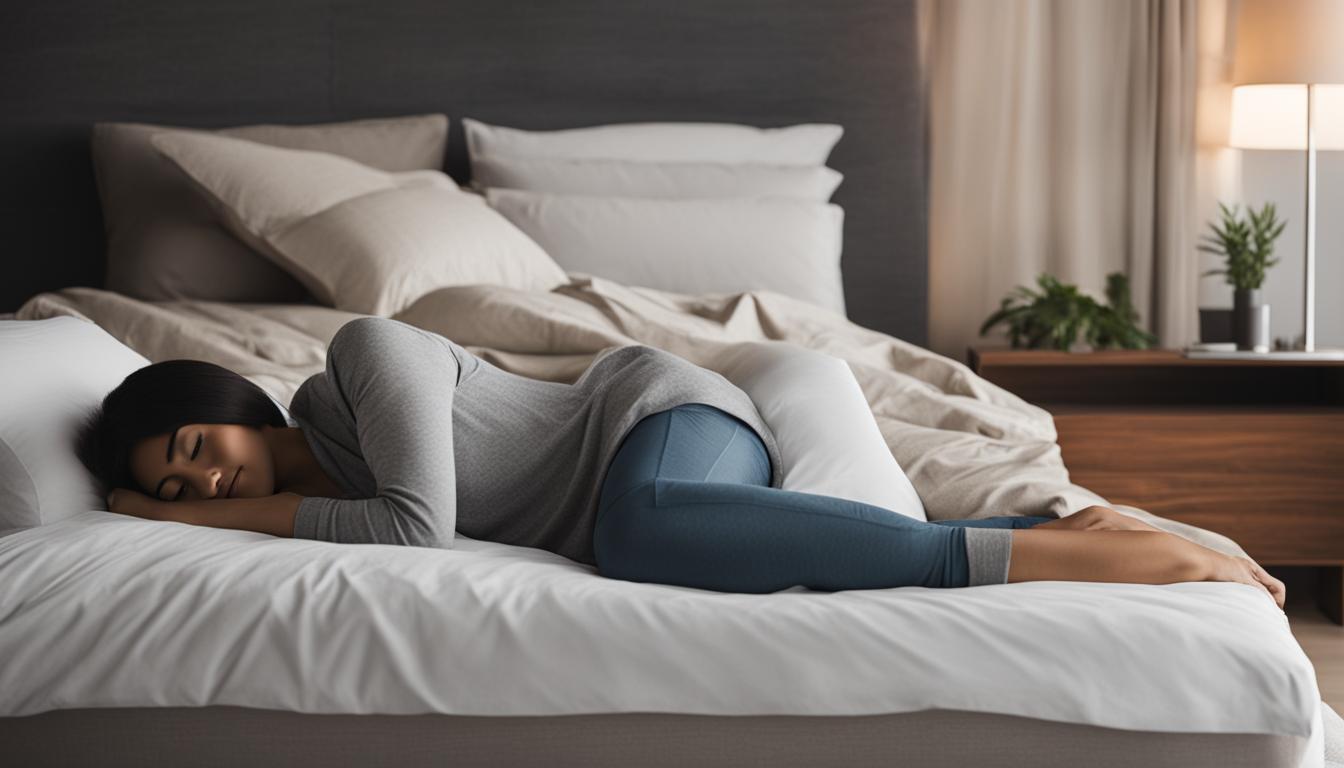How to Sleep Comfortably Despite Lower Back Pain: Strategies for Relief
Sleeping comfortably can be challenging when you're dealing with lower back pain. The discomfort can make it difficult to find a comfortable position and may even lead to disrupted sleep. However, there are strategies you can implement to relieve back pain and improve your sleep quality.
One important aspect to consider is your sleep position. The way you position your body during sleep can have a significant impact on your spinal alignment and the pressure on your lower back. Choosing the right mattress and pillows can also provide the necessary support and comfort for a good night's sleep.
Additionally, practicing relaxation techniques and maintaining good sleep hygiene before bed can help promote better sleep with lower back pain. By incorporating these strategies into your routine, you can find relief and wake up feeling refreshed.
If your back pain persists or worsens, it's essential to seek medical attention for further evaluation. A healthcare provider can assess your condition and provide appropriate treatment options.
Key Takeaways:
- Choose a supportive mattress and pillows to enhance comfort and maintain spinal alignment.
- Practicing relaxation techniques and good sleep hygiene can help improve sleep quality.
- Experiment with different sleep positions, such as side sleeping with a partial bend in the knees, to find what works best for you.
- Seek medical attention if your back pain persists or worsens.
- Listen to your body's needs and adjust your sleep routine accordingly.
Types of Lower Back Pain
When it comes to lower back pain, there are two primary types: acute and chronic. Understanding these distinctions can help individuals better manage their symptoms and seek appropriate treatment.
Acute Lower Back Pain
Acute lower back pain is typically characterized by a sudden onset and lasts for a short duration, usually a few days to a few weeks. It is often caused by an identifiable event or injury, such as lifting heavy objects incorrectly or sudden movements that strain the back muscles. Acute lower back pain is common and can be mild to severe, but it tends to improve with time and self-care measures.
Chronic Lower Back Pain
Chronic lower back pain, on the other hand, persists for three months or longer and may not have a clear link to an initial injury. It can be caused by various factors, including degenerative conditions, repetitive stress, or underlying medical conditions. Chronic lower back pain is more complex and can have a significant impact on an individual's daily life and overall well-being. It requires a comprehensive approach to management, which may include a combination of medical interventions, physical therapy, and lifestyle modifications.
It is estimated that around 20% of cases of acute low back pain become chronic, highlighting the importance of early intervention and appropriate treatment to prevent the transition to chronicity.
Understanding the types of lower back pain is the first step in effectively managing the condition. It is crucial to seek medical evaluation and guidance for an accurate diagnosis and personalized treatment plan. Remember, everyone's experience with lower back pain is unique, and what works for one person may not work for another. Consulting with healthcare professionals is essential to develop an individualized approach to alleviate pain, improve function, and enhance overall quality of life.
How Are Sleep and Lower Back Pain Related?
There is a significant association between sleep and lower back pain. Discomfort from pain can make it challenging to get comfortable enough to fall asleep or may cause nighttime awakenings. On the other hand, sleep problems can also contribute to the development or worsening of pain. The exact mechanisms behind this relationship are not yet fully understood, but sleep deprivation, mood disturbances, and altered pain processing in the brain are among the potential factors.
Research suggests that sleep disturbances can affect pain sensitivity and tolerance. Lack of sleep can lower the pain threshold, making lower back pain feel more intense. Additionally, sleep deprivation can lead to changes in mood and increased stress, which can further amplify the perception of pain. On the flip side, chronic pain can interfere with sleep architecture, causing frequent awakenings and fragmented sleep. This disrupted sleep can negatively impact overall health and well-being.
Sleep disturbances can affect pain sensitivity and tolerance. Lack of sleep can lower the pain threshold, making lower back pain feel more intense.
Furthermore, the relationship between sleep and pain is bidirectional. Sleep disturbances can contribute to the development of chronic pain conditions, including lower back pain. Inadequate sleep can impair the body's ability to recover and heal, potentially leading to the development or worsening of pain. It is a vicious cycle, as pain can then disrupt sleep, perpetuating the cycle of sleep disturbances and increased pain.
The Impact of Sleep on Inflammation and Pain
Sleep also plays a role in regulating inflammation, which is closely linked to pain. Chronic inflammation can contribute to the development and persistence of lower back pain. Studies have shown that inadequate sleep can lead to increased levels of inflammatory markers in the body. This can exacerbate existing inflammation and contribute to the perception of pain.
Improving sleep quality and addressing sleep disturbances can be an essential component of managing lower back pain. Creating a sleep-friendly environment, practicing good sleep hygiene, and seeking appropriate treatment for sleep disorders can help break the cycle of sleep disturbances and pain. It is important to prioritize restorative sleep to support overall health and well-being.
How Do Sleeping Positions Affect Lower Back Pain?
When it comes to managing lower back pain, your sleeping position can make a significant difference in your comfort levels. The best sleeping position for lower back pain is on your side with a partial bend in the knees. This position helps to balance the body and reduce pressure on the lumbar spine, providing relief for your lower back. Back and stomach sleepers can also take steps to minimize strain on their lower back, such as using pillows for support.
An adjustable bed can be particularly beneficial for individuals with back pain. It allows you to customize your sleeping position, finding the angle that provides the most comfort and support. By elevating your upper body slightly, an adjustable bed can reduce pressure on the lower back and promote better spinal alignment.
In addition to adjusting your sleep position, it's essential to choose the right mattress and pillows. Look for a medium-firm mattress that provides adequate support for your back while ensuring comfort. Pillows that offer proper neck and spine alignment can also help alleviate lower back pain.
So, if you're struggling with lower back pain, be mindful of how you sleep. Experiment with different sleeping positions, invest in a supportive mattress and pillows, and consider an adjustable bed for optimal comfort and relief.
Table: Comparison of Sleeping Positions for Lower Back Pain
| Sleeping Position | Advantages | Disadvantages |
|---|---|---|
| Side Sleeping with Partial Bend in Knees | Reduces pressure on the lumbar spine | Can cause shoulder and hip pain if not aligned properly |
| Back Sleeping with Pillow Support | Supports proper spine alignment | May worsen snoring and sleep apnea |
| Stomach Sleeping with Pillow Under Pelvis | Relieves tension in the lower back | Puts strain on the neck and spine |
Tips for Sleeping Better with Lower Back Pain
If you suffer from lower back pain, getting a good night's sleep can be a challenge. However, there are several strategies you can implement to improve your sleep quality and reduce discomfort. Here are some tips for sleeping better with lower back pain:
- Choose the right sleeping position: Finding a supportive sleeping position is essential for relieving lower back pain. Sleeping on your side with a partial bend in the knees is often recommended as it helps maintain spinal alignment and reduces pressure on the lumbar spine.
- Invest in a supportive mattress and pillows: The right mattress and pillows can make a significant difference in your sleep quality. Look for a mattress that provides adequate support and helps distribute your body weight evenly. Additionally, using a supportive pillow that conforms to the natural curvature of your neck and spine can help alleviate pressure on your lower back.
- Practice relaxation techniques: Engaging in relaxation techniques before bed can help calm your mind and prepare your body for sleep. Try deep breathing exercises, progressive muscle relaxation, or gentle stretching to help relax tense muscles and promote a state of relaxation.
- Improve sleep hygiene: Establishing a bedtime routine and practicing good sleep hygiene can contribute to better sleep with lower back pain. Avoid stimulants like caffeine close to bedtime, create a comfortable sleep environment, and ensure that your bedroom is quiet, dark, and at a cool temperature.
By incorporating these tips into your sleep routine, you can improve your sleep quality and find relief from lower back pain. However, it's important to remember that everyone's experience with lower back pain is unique, and it may take some trial and error to find the strategies that work best for you. If your pain persists or worsens, it's always a good idea to consult a healthcare professional for further evaluation and guidance.
| Tips for Sleeping with Lower Back Pain | Sleeping Remedies for Back Pain | Improving Sleep with Lower Back Pain |
|---|---|---|
| Choose the right sleeping position | Invest in a supportive mattress and pillows | Practice relaxation techniques |
| Improve sleep hygiene | Avoid stimulants close to bedtime | Create a comfortable sleep environment |
| Establish a bedtime routine | Consult a healthcare professional if pain persists |
Remember, improving sleep with lower back pain is a gradual process, and it may take time to find the right combination of strategies that work for you. Patience and consistency are key. With a proactive approach and the right support, you can achieve better sleep and alleviate the discomfort associated with lower back pain.
When Should You See a Doctor About Lower Back Pain?
If you are experiencing lower back pain, it is important to know when to seek medical attention. While some cases of back pain may resolve on their own with self-care and time, there are certain signs and symptoms that warrant a visit to a healthcare provider for further evaluation.
If your lower back pain began with a specific injury, such as a fall or an accident, it is crucial to see a doctor. Additionally, if your pain continues or worsens for more than a few days, or if it is accompanied by other concerning symptoms, seeking medical attention is necessary.
Some signs that indicate the need for medical evaluation include:
- Pain that is debilitating and interferes with your daily activities
- Pain that radiates to your legs or other parts of your body
- Weakness or numbness in your legs or feet
- Signs of infection, such as fever or chills
- Unexplained weight loss
It is important to remember that everyone's experience with back pain is unique, and what may be concerning for one person may not be for another. However, if you are unsure or have any doubts about your symptoms, it is always best to err on the side of caution and consult a healthcare professional.
| Symptom | When to See a Doctor |
|---|---|
| Your pain began with a specific injury | Seek medical attention to rule out any underlying issues or fractures. |
| Your pain continues or worsens for more than a few days | A healthcare provider can evaluate your pain and recommend appropriate treatment. |
| Your pain is debilitating and interferes with daily activities | A doctor can assess the severity of your pain and provide a comprehensive treatment plan. |
| Your pain radiates to your legs or other parts of your body | Medical evaluation is necessary to determine the underlying cause of your symptoms. |
| You experience weakness or numbness in your legs or feet | A healthcare professional can assess your nerve function and recommend appropriate management. |
| You have signs of infection, such as fever or chills | Immediate medical attention is necessary to treat the infection and address the underlying cause of your pain. |
| You have unexplained weight loss | Consult a healthcare provider to investigate potential underlying causes of your weight loss and back pain. |
The Benefits of Sleeping with a Pillow Between Your Knees
Sleeping with a pillow between your knees can provide numerous benefits for individuals experiencing lower back pain. By maintaining proper spinal alignment, this simple technique can significantly improve posture, alleviate back pain, and even reduce hip and sciatica pain. Placing a pillow between your knees while sleeping helps to keep the knees aligned, which in turn reduces pressure and strain on the lower back.
One of the primary benefits of using a pillow between your knees is the improved spinal alignment it allows for. When we lie on our sides without proper support, the top leg can pull the spine out of alignment and create stress on the lower back. By placing a pillow between the knees, we create a stable base that supports the natural curvature of the spine and reduces the risk of developing or exacerbating lower back pain.
“Sleeping with a pillow between the knees can significantly improve comfort and promote proper spinal alignment, relieving pressure on the lower back.”
Additionally, a pillow between the knees helps to relieve tension in the lower back and reduce pain. By supporting the alignment of the spine, it helps to alleviate pressure on the nerves and reduce discomfort. This can lead to a more restful and pain-free sleep, allowing individuals with lower back pain to wake up feeling rejuvenated and ready for the day.
Summary:
- Sleeping with a pillow between your knees promotes proper spinal alignment.
- It alleviates pressure and strain on the lower back, reducing back pain.
- The pillow helps relieve tension in the lower back and reduces discomfort.
- Using a pillow between the knees can lead to a more restful and pain-free sleep.
The Benefits of Sleeping with a Pillow Under Your Knees
When it comes to finding relief from lower back pain during sleep, placing a pillow under your knees can offer significant benefits. By supporting the natural alignment of the spine, this simple technique can help alleviate pressure on the lower back and promote a more comfortable and pain-free sleep.
By elevating the knees slightly with a pillow, you can help maintain the normal curve of the lower back. This position reduces strain on the spine and distributes weight more evenly, relieving pressure on the lumbar region. This can be particularly beneficial for back sleepers who tend to experience increased lower back pain due to the direct pressure on the spine.
Adding a pillow under your knees not only supports proper spinal alignment but also helps improve circulation by reducing compression on blood vessels. By enhancing blood flow to the lower extremities, it can help alleviate swelling and discomfort, especially for those with conditions such as sciatica or varicose veins.
Incorporating a pillow under your knees can also enhance relaxation by reducing muscle tension and promoting a more comfortable sleep position. Relaxed muscles are less likely to spasm or experience cramping, providing a more restful and rejuvenating sleep experience.
In summary, sleeping with a pillow under your knees offers several benefits for individuals with lower back pain. It helps maintain proper spinal alignment, distributes weight evenly, improves circulation, and promotes muscle relaxation. By incorporating this simple technique into your sleep routine, you can effectively reduce pain and wake up feeling refreshed and revitalized.
The Benefits of Sleeping with a Pillow Under Your Stomach
Stomach sleepers often experience back pain due to the strain placed on the lower back. However, sleeping with a pillow under your stomach can provide significant relief and improve your sleep quality. Placing a pillow under your pelvis or thighs helps reduce strain on the back and relieves tension in the lower back.
By supporting the natural curve of the spine, the pillow under your stomach alleviates pressure on the nerves, offering pain relief and improved sleep. This position helps to maintain proper spinal alignment, which is essential for reducing discomfort and promoting a comfortable sleep experience.
When using a pillow under your stomach, it's important to choose a pillow that provides adequate support and conforms to your body shape. Look for a pillow with medium firmness to ensure optimal comfort and alignment. Experimenting with different pillow sizes and materials can help you find the perfect pillow that suits your needs.

Key Benefits of Sleeping with a Pillow Under Your Stomach:
- Relieves strain on the back and reduces tension in the lower back
- Supports the natural curve of the spine and alleviates pressure on the nerves
- Improves spinal alignment and reduces discomfort during sleep
- Promotes better sleep quality and reduced back pain
Remember that finding the right sleeping position is a personal preference, and it may take some trial and error to discover what works best for you. If you experience persistent or severe back pain, it is always a good idea to consult with a healthcare professional for personalized advice and guidance.
Conclusion
In summary, effectively managing lower back pain during sleep requires a combination of strategies. By optimizing your sleep position, using supportive pillows and mattresses, practicing relaxation techniques, and seeking professional medical advice when necessary, you can improve your sleep quality and find relief from discomfort.
Experiment with different sleeping positions to find the one that works best for you. Side sleepers should try placing a pillow between their knees to maintain spinal alignment, while back sleepers can benefit from placing a pillow under their knees to reduce pressure on the lower back. Stomach sleepers can find relief by using a pillow under their pelvis or thighs to alleviate strain on the back.
In addition, investing in a mattress and pillows that provide adequate support is crucial. Look for options that offer proper spinal alignment and cushioning for your specific needs. Remember to practice relaxation techniques before bed, such as deep breathing or stretching, to calm your mind and body for a more restful sleep.
If your lower back pain persists or worsens, it is important to consult a healthcare professional for further evaluation and guidance. They can provide a proper diagnosis, recommend appropriate treatment options, and ensure that any underlying conditions are addressed.
FAQ
How can I sleep comfortably despite lower back pain?
There are several strategies you can try to improve sleep comfort with lower back pain. These include finding a supportive sleeping position, using the right mattress and pillows, practicing relaxation techniques, and seeking medical attention when necessary.
What are the different types of lower back pain?
There are two primary types of lower back pain: acute and chronic. Acute lower back pain lasts for a few days to a few weeks and is often associated with an injury or identifiable event. Chronic lower back pain persists for three months or longer and may not have a clear link to an initial injury.
How are sleep and lower back pain related?
There is a significant association between sleep and lower back pain. Discomfort from pain can make it challenging to get comfortable enough to fall asleep or may cause nighttime awakenings. On the other hand, sleep problems can also contribute to the development or worsening of pain.
How do sleeping positions affect lower back pain?
Sleeping position plays a crucial role in how lower back pain is experienced. The best sleeping position for lower back pain is on your side with a partial bend in the knees. Back and stomach sleepers can also take steps to reduce strain on their lower back, such as using pillows for support.
What can I do to sleep better with lower back pain?
To sleep better with lower back pain, you can try finding a supportive sleeping position, being mindful of how you get in and out of bed, using the right mattress and pillows, practicing relaxation techniques, and improving sleep hygiene.
When should I see a doctor about lower back pain?
It is important to seek medical attention for lower back pain if the pain began with a specific injury, continues or worsens for more than a few days, is debilitating, radiates to other parts of the body, or is accompanied by weakness, numbness, signs of infection, or other unexplained health changes.
What are the benefits of sleeping with a pillow between my knees?
Sleeping with a pillow between your knees can help maintain proper spinal alignment, improve posture, relieve back pain, and reduce hip and sciatica pain. It reduces pressure and strain on the lower back while sleeping.
What are the benefits of sleeping with a pillow under my knees?
Sleeping with a pillow under your knees can help maintain the normal curve of the lower back, distribute weight more evenly, relieve pressure on the spine, and reduce strain on the lower back. It promotes a more comfortable and pain-free sleep.
What are the benefits of sleeping with a pillow under my stomach?
Sleeping with a pillow under your pelvis or thighs can reduce strain on the back, relieve tension in the lower back, support the natural curve of the spine, alleviate pressure on the nerves, and offer pain relief and improved sleep.
Source Links
- https://backintelligence.com/how-to-sleep-with-lower-back-pain/
- https://www.cnet.com/health/sleep/this-trick-can-help-you-relieve-lower-back-pain/
- https://www.sleepfoundation.org/physical-health/how-to-sleep-with-lower-back-pain











Leave a Reply